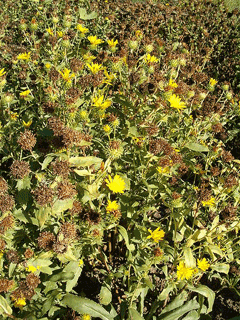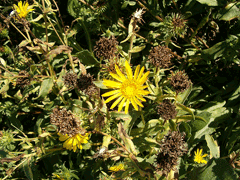 |
|
http://commons.wikimedia.org/wiki/User:BotBln |
 |
| http://commons.wikimedia.org/wiki/User:BotBln |
Translate this page:
Summary
Physical Characteristics

 Grindelia robusta is a PERENNIAL growing to 0.6 m (2ft).
Grindelia robusta is a PERENNIAL growing to 0.6 m (2ft).
See above for USDA hardiness. It is hardy to UK zone 7. It is in flower from May to September. The species is hermaphrodite (has both male and female organs) and is pollinated by Insects.
Suitable for: light (sandy) and medium (loamy) soils, prefers well-drained soil and can grow in nutritionally poor soil. Suitable pH: mildly acid, neutral and basic (mildly alkaline) soils and can grow in saline soils.
It cannot grow in the shade. It prefers dry or moist soil and can tolerate drought.
UK Hardiness Map
US Hardiness Map
Synonyms
Plant Habitats
Cultivated Beds;
Edible Uses
Edible Parts: Leaves
Edible Uses:
Leaves - raw[257].
References More on Edible Uses
Medicinal Uses
Plants For A Future can not take any responsibility for any adverse effects from the use of plants. Always seek advice from a professional before using a plant medicinally.
Antispasmodic Blood purifier Demulcent Expectorant Parasiticide Sedative Stomachic
The leaves and flowering tops are antiphlogistic, antispasmodic, balsamic, demulcent, expectorant, sedative, stomachic and a vascular tonic[4, 7, 21, 46, 61, 207, 213]. Blood purifier[4]. The plant is applied externally as a compress on inflamed or irritated areas of the skin[7, 257]. Used internally, it slows down the heartbeat and reduces the stimulation of the nerve endings in the air passages that causes coughing - it is therefore extremely effective as a calming agent in the treatment of asthma[7]. The fluid extract is prepared by placing the freshly gathered leaves and flowers in a small quantity of simmering water for about 15 minutes[213]. The plant is used to treat people affected by poison-ivy[213].
References More on Medicinal Uses
The Bookshop: Edible Plant Books
Our Latest books on Perennial Plants For Food Forests and Permaculture Gardens in paperback or digital formats.

Edible Tropical Plants
Food Forest Plants for Hotter Conditions: 250+ Plants For Tropical Food Forests & Permaculture Gardens.
More

Edible Temperate Plants
Plants for Your Food Forest: 500 Plants for Temperate Food Forests & Permaculture Gardens.
More

More Books
PFAF have eight books available in paperback and digital formats. Browse the shop for more information.
Shop Now
Other Uses
Dye Hair Parasiticide
Yellow and green dyes are obtained from the flowering heads and pods[168]. Aromatic. A decoction of the roots has been used as a hair shampoo to kill lice[257].
Special Uses
References More on Other Uses
Cultivation details
Succeeds in any well-drained soil in full sun[200]. Does well on dry sandy banks and in poor soils[200]. Plants tend to concentrate selenium in the leaves and stems, this is especially noticeable on soils that are relatively rich in that element[21]. Some authorities class this species as a synonym of G. camporum.
References Carbon Farming Information and Carbon Sequestration Information
Temperature Converter
Type a value in the Celsius field to convert the value to Fahrenheit:
Fahrenheit:
The PFAF Bookshop
Plants For A Future have a number of books available in paperback and digital form. Book titles include Edible Plants, Edible Perennials, Edible Trees,Edible Shrubs, Woodland Gardening, and Temperate Food Forest Plants. Our new book is Food Forest Plants For Hotter Conditions (Tropical and Sub-Tropical).
Shop Now
Plant Propagation
Seed - sow autumn or spring in a cool greenhouse and only just cover the seed. Prick out the plants into individual pots when they are large enough to handle and plant them out into their permanent positions in early summer.
Other Names
If available other names are mentioned here
Native Range
NORTHERN AMERICA: United States (California)
Weed Potential
Right plant wrong place. We are currently updating this section.
Please note that a plant may be invasive in one area but may not in your area so it's worth checking.
Conservation Status
IUCN Red List of Threatened Plants Status :

Growth: S = slow M = medium F = fast. Soil: L = light (sandy) M = medium H = heavy (clay). pH: A = acid N = neutral B = basic (alkaline). Shade: F = full shade S = semi-shade N = no shade. Moisture: D = dry M = Moist We = wet Wa = water.
Now available:
Food Forest Plants for Mediterranean Conditions
350+ Perennial Plants For Mediterranean and Drier Food Forests and Permaculture Gardens.
[Paperback and eBook]
This is the third in Plants For A Future's series of plant guides for food forests tailored to
specific climate zones. Following volumes on temperate and tropical ecosystems, this book focuses
on species suited to Mediterranean conditions—regions with hot, dry summers and cool, wet winters,
often facing the added challenge of climate change.
Read More
Expert comment
Author
Nutt.
Botanical References
200
Links / References
For a list of references used on this page please go here
Readers comment